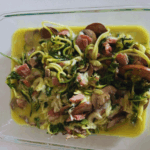This post reflects on my 100 miles of solo backpacking on the Superior Hiking Trail with a chronic condition called Mast Cell Activation Syndrome (MCAS).
Table of Contents
I’ve Backpacked 100 Miles!
I’ve hiked 100 miles on the Superior Hiking Trail, and I have completed one-third of the approximately 300-mile trail. When I started this journey in June I had a vague sense that I wanted to test my limits by doing a solo backpacking section hike on the SHT. I didn’t know my physical capacity, and I was doubtful I could hike more than a few miles at a time. Over the past two and a half months I’ve learned a lot! Here’s a recap of what I’ve discovered while I’ve been privileged to experience this sacred time in nature:
Nature Heals
I followed an intuition that told me to start hiking the SHT. I wasn’t sure what was calling me out into the wild but soon enough I realized that nature heals me. By spending time directly in nature my mast cell activation syndrome symptoms dramatically reduced and I was able to cut back significantly on mast cell stabilizers. I learned that I wasn’t completely healed and when I pushed myself too hard I experienced an MCAS symptom flare. But the time in nature had a clear positive impact on my health and I knew wanted to get right back on the trail as soon as I returned from a section.
Being in nature also stilled my mind in a way that few other activities do. I’ve never enjoyed sitting meditation, but this journey has surely been a meditative movement activity. I realized that I was happiest when I was mindfully taking each step on the trail, feeling gratitude for this opportunity, and thankfulness for the beauty around me.
I Backpacked Into Strength
In the winter months, I cross-country ski because it makes me feel amazing. I love being out in the woods moving my body. But up until this year, I didn’t have an equivalent activity for the summer months. Walking didn’t raise my heart rate enough, but running stressed my body too much. When I stumbled upon backpacking I found that it satisfied me in the same way Nordic skiing did. For me, backpacking provides the same immersion in nature and enjoyment from moving my body as Nordic skiing with roughly the same amount of effort.
While hiking six separate section hikes, I increased my distance from ten miles per three-day section to nearly 30 miles per section. I gained stamina and strength and learned I could handle longer distances with greater ease. I hiked over 100 miles and took over 318,000 steps!
I Got Proper Equipment and Gained Skills
Over the last three years, I did a lot of car camping. Having light and efficient gear appealed to me and I started accumulating ultralight backpacking gear slowly a couple of years before this journey was even in my imagination. By June when I decided to try the SHT I owned a basic camping setup.
But before starting my section hike this summer I didn’t own a backpack. I had never backpacked alone. I’d never made my own dehydrated meals or hung a bear bag from a tree. I’d never filtered water from a stream or slept comfortably on an inflatable sleeping pad. The times I’d car-camped outside I’d never been warm enough through the night.
Throughout this journey, I fine-tuned my gear and gathered skills from backpackers on YouTube. I learned to eliminate redundant gear and to pack my things systematically. I swapped out an ill-fitting backpack and a flimsy tent for better options. I learned how to use a satellite device for navigation and communication, and I figured out which app I liked best for tracking my progress on the trail. I conquered my resistance and learned how to hang my food bag in a tree so that bears couldn’t get at it while I slept.
And my new backpacking systems worked well! I learned I could sleep cozy and warm in a wet tent. I figured out how to satisfy my nutrition needs on the trail while still adhering to my MCAS food limitations, and I’ve eaten delicious homemade dehydrated meals!
Listening to Myself
For many people thru-hiking or section hiking the SHT, the goal is to complete the entire 300 miles as fast as possible. I know I can do hard things, and I can push myself past the point of pain. But the more time I spent on the SHT, the more it became clear that wasn’t the point for me. Early on, the goal became enjoying every step on the path, listening to my inner guidance, and overriding the pressure to hurry or push.
I recognized my compulsion to do the entire Superior Hiking Trail, but I also realized that I enjoyed plodding along at about 1.5 miles per hour, no more than 8 miles per day, with rest days between sections. If necessary I know I can now hike over 10 miles at once, but it isn’t comfortable while doing it or afterward.
Carrying Appropriate Weight for My Body
A backpacker can comfortably carry about 15 percent of their body weight on their back. I’m 5’2” and at my weight, I should carry less than 19.5 pounds. The more miles I’ve hiked this summer the more weight I’ve lost, reducing that number. With a base pack weight of 12 pounds (before food and water), I need to be careful about carrying too heavy a pack.
That’s complicated because of the scarcity of water in certain sections. When I increased the amount of water I carried I began to experience knee pain. At 2.2 pounds per liter, water is really heavy. When I carried too much weight or covered too many miles in a day it was painful.
Why I’m Doing This Hike
The most compelling reason to continue hiking the SHT is that I feel so good when I am out in nature. Nature resets my mind, and brings me back in touch with what matters most. I don’t have fun when I slog through miles just to check them off. So, I’m hiking to enjoy each step, moving mindfully, and I’m letting go of other people’s goals for the SHT.
What’s Next?
I may do another section or two of the SHT before October 1, but I won’t complete the whole SHT this season. After camping near Beaver River, which abuts a more urban area, I realized I don’t like that type of camping. My favorite campsites have been out of cell service and away from noise and humanity near Grand Marais, so I may end up completely skipping the section of the SHT south of Hwy. 301, and I’m fine with that.
This has been a journey of discovering what brings me peace, touching the edges of my physical capacity, AND honing my self-compassion. I’ve covered 100 miles and realized I don’t want to do certain parts of the SHT that won’t feed my soul. I’ve found an activity that lets me experience the wonder of nature while healing my body and mind. And I’m profoundly grateful I have had the chance to do this! Thanks for following along!





What is MCAS?
Mast Cell Activation Syndrome (MCAS) is a chronic condition that affects all organ systems. It can cause severe, disabling symptoms every day, including potentially fatal anaphylaxis. MCAS often occurs with other chronic conditions like Ehlers-Danlos Syndrome (EDS) and Postural Orthostatic Tachycardia Syndrome (POTS). Managing MCAS is challenging because many healthcare providers are unaware of it, and diagnostic tests can be unreliable. Treatments involve using antihistamines, mast cell stabilizers, and avoiding triggers. Check out this post on how to manage MCAS.
The bucket theory
The bucket theory simplifies understanding symptom reactions with MCAS. Imagine your body as an empty bucket you don’t want to overflow. Reactions to various stimuli fill the histamine bucket at different rates, forming the total histamine level (how full your bucket is). More histamine means more symptoms. By managing triggers, reducing exposures, and taking medications and supplements, you can control your bucket’s level.
Know your typical symptom progression
Knowing your symptom progression in a symptom flare is the key to developing your rescue plan. This post discusses how to recognize your symptom progression to be prepared to address those symptoms.
Get my free ebook, symptom log, and meal plan!
Want a tool to easily keep track of your symptoms? Sign up for my newsletter and you will receive my free 50-page ebook of lower-histamine, grain-free, sugar-free recipes, my free symptom log, and a free two-week meal plan!
Sign up for the SSP!
The SSP is a listening therapy based on Polyvagal Theory created by Stephen Porges to unlock your ability to think, feel, and connect better through nervous system regulation. You use the SSP via an app on your phone and listen with over-the-ear headphones to specially filtered music that heals the nervous system, specifically the vagus nerve. You subscribe to the app with a provider like me and listen to the specially curated music for 30 minutes each day for a 5-hour cycle. Studies show the SSP has a profound effect on mental health and chronic conditions
You can sign up for the SSP here!
Order my book!
Rocks and Roots chronicles my journey solo backpacking the Superior Hiking Trail and overcoming nervous system dysregulation, gut dysbiosis, and Mast Cell Activation Syndrome symptoms to hike 328 miles successfully.
Check out this powerful frequency device
Healy is an individualized microcurrent device I use to reduce inflammation. Check out this post for more about Healy.
Sign up for a session!
I provide one-on-one in-person and remote chronic illness and caregiver coaching and Sacred Self-Healing Sessions based on the Sacred Self-Healing Method, a proven novel co-creative healing modality detailed in my Books.
Click here for more information.
What do you think?
I’d love to have your reply below!
Disclaimer
The preceding material does not constitute medical advice. This information is for information purposes only and is not intended to be a substitute for professional medical advice, diagnosis, cure or treatment. Always seek advice from your medical doctor.

